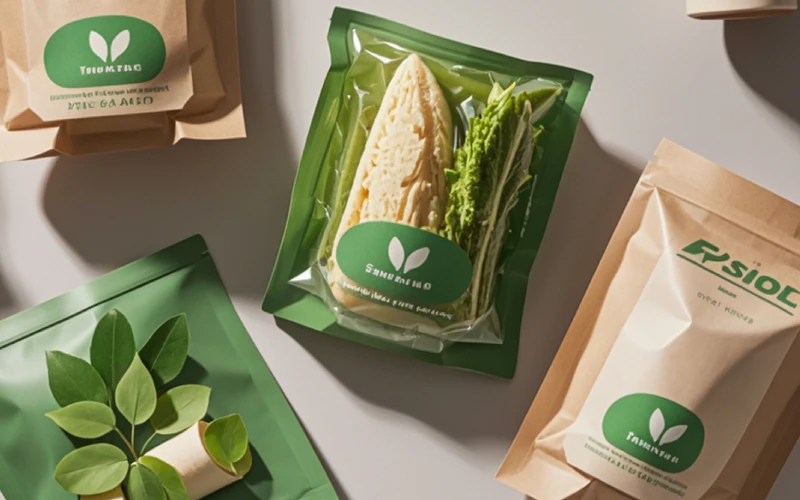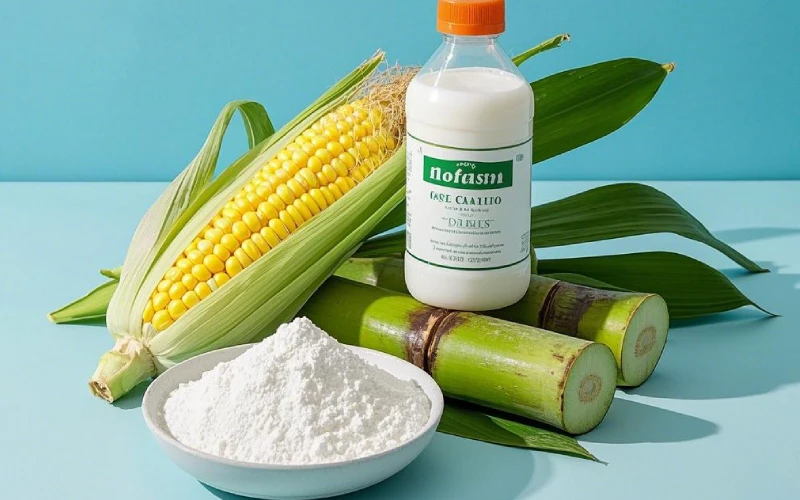The biodegradable food packaging market is experiencing significant growth due to increasing environmental awareness and regulatory pressures. Valued at approximately $4 billion in 2021, it is projected to reach around $10 billion by 2028.

Key applications include packaging for fresh produce, baked goods, ready-to-eat meals, and takeaway containers. Materials such as plant-based bioplastics, paper, and compostable films are commonly used.
This shift not only reduces plastic waste but also promotes sustainable consumption, making it a vital segment in the broader eco-friendly packaging industry. Innovations in material science continue to drive advancements in functionality and consumer acceptance.
What is Biodegradable Food Packaging?

Biodegradable food packaging refers to packaging materials that are designed to break down naturally after use. Unlike traditional plastic packaging, which can take centuries to decompose, biodegradable materials can be broken down by microorganisms in the environment, leaving behind little to no waste.
This innovative solution is quickly gaining momentum as companies and consumers seek to reduce their environmental footprint and move towards more sustainable practices.
At BN PACK, we are proud to be a leading manufacturer of biodegradable food packaging solutions. As a manufacturer of biodegradable bags, we have a unique opportunity to provide businesses with high-quality, eco-friendly packaging options that meet the growing demand for sustainable solutions.
What Makes Food Packaging Biodegradable?

Biodegradable food packaging is made from materials that naturally decompose through the action of bacteria, fungi, or other natural processes. These materials, often derived from plant-based sources such as corn starch, sugarcane, or algae, are engineered to break down into water, carbon dioxide, and organic matter. As they degrade, they do not leave harmful residues, unlike plastic, which can remain in the environment for hundreds of years.
The Rise of Eco-Friendly Packaging
The demand for biodegradable packaging has surged in recent years due to rising environmental concerns and the growing awareness of the devastating impact of plastic waste. Governments around the world are also implementing stricter regulations on single-use plastics, encouraging businesses to shift towards more sustainable packaging options.
Why Choose Biodegradable Over Conventional Plastic Packaging?
Traditional plastic packaging is made from petroleum-based materials that take hundreds of years to break down. In contrast, biodegradable packaging materials are derived from renewable resources and decompose within months or years, depending on the material and environmental conditions. Biodegradable food packaging reduces waste, lowers pollution, and helps preserve natural resources.
| Packaging Type | Main Advantages |
|---|---|
| Biodegradable Food Packaging | Decomposes naturally, reducing landfill waste. Made from renewable resources. Reduces carbon footprint. Often compostable, enriching soil. |
| Plastic Packaging | Durable and lightweight. Water-resistant. Cost-effective for mass production. Versatile in design applications. |
| Paper Packaging | Biodegradable and recyclable. Lightweight and versatile. Better printability for branding. Less energy-intensive to produce compared to plastic. |
| Cloth Packaging | Reusable and durable. Eco-friendly and sustainable. Can be customized for various uses. Reduces single-use waste. |
| Foam Packaging | Excellent insulation properties. Lightweight and moisture-resistant. Provides good cushioning for fragile items. Often cost-effective for manufacturers. |
BN PACK: Leaders in Biodegradable Food Packaging
BN PACK has been at the forefront of biodegradable packaging solutions, providing high-quality products designed to meet the needs of businesses looking for sustainable alternatives. Our biodegradable bags are manufactured using advanced techniques that ensure strength, durability, and reliability, all while maintaining environmental friendliness.
Types of Biodegradable Food Packaging Solutions

Biodegradable food packaging bags is available in various forms, including bags, wraps, and containers. Each type is designed to meet the specific needs of different food products, whether it’s fresh produce, snacks, or prepared meals. BN PACK offers a variety of biodegradable bags tailored to the food packaging industry.
Plant-Based Plastics: Made from renewable resources like corn or sugarcane, these bioplastics, such as PLA (polylactic acid), are commonly used for containers, utensils, and bags.
Compostable Films(biodegradable film for food packaging): Thin films made from materials like cellulose or starch that decompose in composting environments, ideal for wrapping foods.
Biodegradable Paper Products: Paper and cardboard, treated with biodegradable coatings, suitable for cartons, bags, and wraps.
Mushroom Packaging: Made from mycelium, this innovative solution serves as a sustainable alternative for cushioning and shipping.
Seaweed-Based Packaging: Edible and biodegradable, this type can replace traditional plastic wrap and containers.
Bagasse Packaging: Derived from sugarcane pulp, it is used for plates and containers, offering durability and compostability.
How Biodegradable Packaging Benefits the Environment
Switching to biodegradable food packaging has numerous environmental advantages. By reducing plastic waste, lowering carbon emissions, and using materials sourced from sustainable agriculture, biodegradable packaging helps protect ecosystems, reduce pollution, and conserve natural resources.
Key Advantages of Biodegradable Food Packaging
Biodegradable packaging offers several key advantages over traditional plastic alternatives, including environmental benefits, cost savings, and improved consumer appeal. Here are the seven main reasons to make the switch to biodegradable food packaging:
Eco-Friendly and Sustainable
Eco-friendly packaging is made from renewable resources and designed to minimize environmental impact. It supports sustainability initiatives, conserving natural resources while reducing pollution and waste accumulation.
Cost-Effective in the Long Run
While initial costs may be higher, eco-friendly packaging can lead to savings over time. Reduced waste disposal fees and potential tax incentives, along with increasing consumer demand, enhance long-term cost efficiency.
Better for Health and Safety
Many biodegradable materials are free from harmful chemicals found in traditional plastics. This ensures safer food contact, reducing the risk of contamination and promoting healthier consumption for consumers.
Consumer Appeal and Brand Image
Adopting eco-friendly packaging enhances a brand’s reputation among environmentally conscious consumers. It demonstrates corporate responsibility, attracting a loyal customer base and differentiating products in a competitive market.
Compliance with Government Regulations
As regulations around plastic use tighten globally, biodegradable packaging helps businesses comply with environmental standards. This proactive approach minimizes legal risks and aligns with sustainability goals promoted by governments.
Versatility in Packaging Solutions
Biodegradable packaging comes in various forms, including bags, containers, and films, tailored for diverse applications. This versatility allows brands to innovate while meeting specific consumer needs across different food categories.
Quick Decomposition and Minimal Waste
Biodegradable packaging typically decomposes within months under proper conditions, significantly reducing landfill waste. This rapid breakdown contributes to a healthier ecosystem, minimizing the long-term environmental footprint.
The Future of Biodegradable Food Packaging
As technology and innovation in the sustainable packaging industry continue to evolve, the future looks bright for biodegradable packaging. The materials used are becoming more efficient, versatile, and accessible, offering new possibilities for food packaging applications across industries.
FAQs
What materials are used to make biodegradable food packaging?
Biodegradable food packaging is often made from plant-based materials like cornstarch, sugarcane, and algae.
How long does it take for biodegradable packaging to decompose?
Depending on the material, biodegradable packaging can break down in a few months to a couple of years.
Is biodegradable food packaging safe for food?
Yes, biodegradable packaging is generally safe for food as it meets specific food-grade safety standards.
Can biodegradable packaging be recycled?
While biodegradable packaging can be composted, recycling options may vary based on the material.
Can biodegradable packaging be recycled?
While biodegradable packaging can be composted, recycling options may vary based on the material.
How does biodegradable packaging compare to compostable options?
Biodegradable packaging breaks down naturally, while compostable packaging is designed to decompose in composting environments.
Can biodegradable packaging be used for all food types?
Yes, biodegradable packaging is versatile and can be used for various food products, although certain items may require specialized packaging.
Conclusion
As sustainability becomes increasingly important to consumers and businesses alike, switching to biodegradable food packaging offers a tangible solution to the growing waste crisis.
At BN PACK, we are committed to providing high-quality biodegradable packaging solutions that help businesses reduce their environmental impact while enhancing their brand image.
